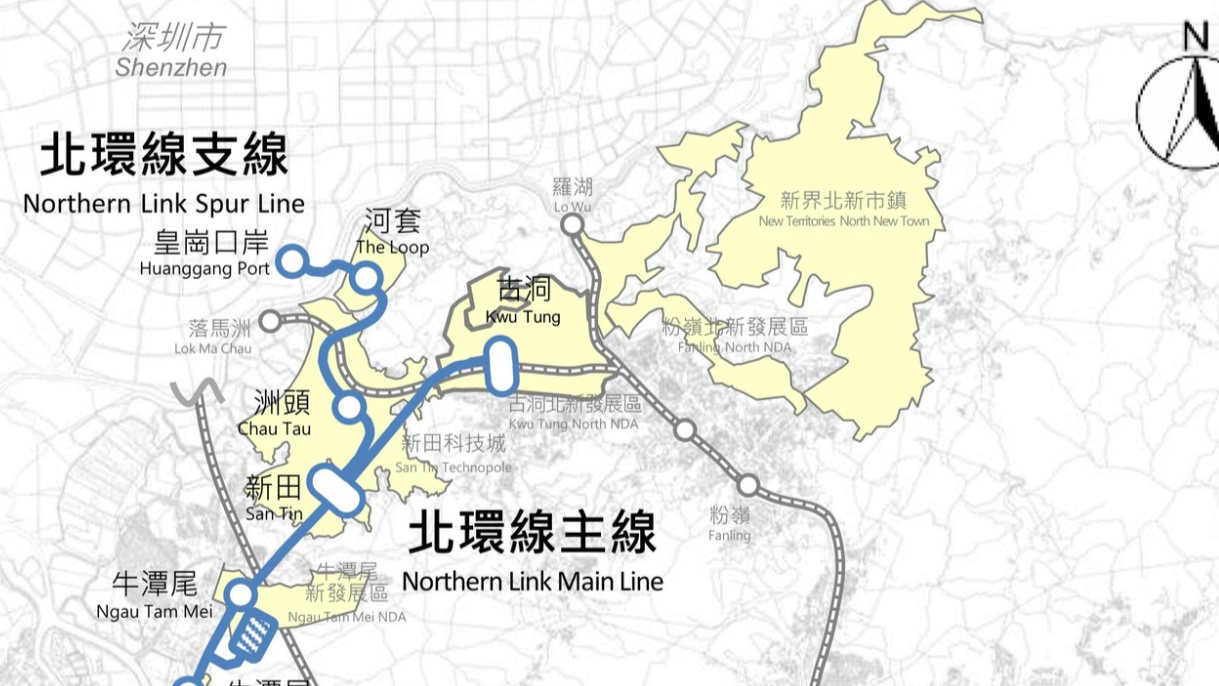Tunnel boring machines, modular construction among borrowed expertise

The Northern Link railway project in Hong Kong will adopt Chinese mainland construction techniques, notably advanced super-large-diameter tunnel boring machines (TBMs) and modular construction, to achieve its ambitious plan of significant cost savings and expedite completion within two years.
Equipped with a 5G network, artificial intelligence, and BeiDou satellite navigation, such advanced TBMs could be a “key cost and productivity driver for the Northern Link project”, which adopts an underground option throughout its approximately 17-kilometer-long railway alignment, a spokesman for the city’s Highways Department told China Daily.
Additionally, modular construction techniques — where station components are prefabricated off-site — are expected to reduce on-site assembly time and improve overall efficiency.
These are just two examples of China’s state-of-the-art capabilities in railway development, the spokesman said, citing the nation’s well-established 162,000-km-long railway network as of 2024.
“Our nation has exhibited phenomenal construction and cost efficiency in infrastructure development. The mainland boasts an unprecedented scale of transport infrastructure, in particular the railway network, and has been the leader in railway construction,” the spokesman said.
The decision to adopt the mainland’s expertise and experience was announced earlier this month by the city’s Highways Department. The 17-km underground rail line, a key rail line running through the Northern Metropolis — the city's new town currently under development — is expected to open by 2034, two years ahead of schedule. The link comprises the main line and the spur line linking up with Shenzhen’s Huanggang port. The cross-boundary spur line includes a 1-km section on the Chinese mainland, which follows different design standards, signaling, and broadcasting systems, which could complicate planning and construction.
ALSO READ: HK’s Northern Link to be ready by 2034, two years ahead of schedule
Lawmaker from the engineering sector Lo Wai-kwok believes that Hong Kong and the mainland — which both boast high-standard railway systems — can create a win-win situation for both sides with closer collaboration in planning, design, and construction.
“For instance, mainland innovations in tunnel boring and bridge construction could benefit Hong Kong’s infrastructure projects,” Lo said.
Lo anticipated that constructing the spur line tunnel separately in Hong Kong and Shenzhen would be more time-consuming, technologically challenging, and costly.
Allowing Shenzhen contractors to manage cross-border tunnel sections would streamline construction, as opposed to splitting work between Hong Kong and Shenzhen, Lo said.
Lo highlighted recent successes that demonstrate the benefits of integrating technologies from the mainland and Hong Kong. One example is the Sky Bridge at Hong Kong International Airport — the world's longest airside bridge, capable of accommodating an A380 aircraft beneath it. The bridge components were prefabricated in Zhongshan, Guangdong province before installation, connecting Terminal 1 with the Terminal 1 satellite concourse.
Apart from the mainland’s cutting-edge technologies, national standards for building cross-boundary railway projects will also be introduced, ensuring that they align with local circumstances and statutory requirements, including wind load calculations, fire safety rules, and MTR service requirements, the department said.
“The goal is to establish a new set of railway specifications that incorporate global best practices, including mainland technologies, while meeting Hong Kong’s compliance needs,” the spokesman added.
Lo agreed with the approach, saying the joint collaboration in infrastructure construction could also establish unified “Guangdong-Hong Kong-Macao Greater Bay Area standards” for railway development.
ALSO READ: Cross-sea link link boosts regional ties, benefits HK and beyond
While both Hong Kong and mainland railway systems adhere to world-class standards, historical differences in construction practices remain. Lo urged the Hong Kong Special Administrative Region government to streamline regulations, allowing suitable mainland standards to be adopted where beneficial, with proper oversight and coordination between professionals on both sides.
While Hong Kong can learn from the mainland’s experience in accelerating station and railway construction, optimizing the design of components and equipment, the city’s more internationally oriented development model with a service management approach tailored to local residents’ daily needs also represents valuable experience for cross-border collaboration.
“While this is not a railway project, it demonstrates how leveraging Chinese mainland technology and standards can bring advantages to Hong Kong's infrastructure development.”
The introduction of mainland standards and construction practices will also create a favorable environment for mainland enterprises to speed up the cross-boundary railway project as it will allow them to fully leverage the productivity edges of their plant, equipment, procurement channels and other resources as well, the spokesman added.
Legislator Michael Tien Puk-sun, a former chairman of the Kowloon-Canton Railway Corp, also concurred that using mainland standards and labor could cut total costs by up to 30 percent, potentially saving hundreds of billions of Hong Kong dollars.
Tien explained that 70 percent of the railway project cost is for infrastructure development, including tracks, tunnels, bridges and stations, while the other 30 percent is for the procurement of electromechanical equipment, such as signaling systems, platform doors and gates — which could potentially be sourced from Chinese mainland suppliers.
Significant cost savings, accounting for 30 percent of the total cost, could be realized in the infrastructure portion by adopting mainland standards and practices — half from using mainland construction standards, and half through employing mainland labor, which is more cost-effective than Hong Kong's multi-tiered subcontracting system.
Tien also suggested that the government could adjust Hong Kong's current standards to achieve cost reductions without sacrificing safety.
Contact the writer at stacyshi@chinadailyhk.com


